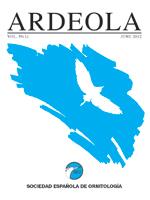We update and present relevant information regarding the abundance and distribution of the great bustard Otis tarda in Castilla y León (Spain) in 2008, compare it with previous census results, and analyse the effects of agricultural changes on the provincial abundance and distribution of the species. The study area was surveyed from four-wheel drive vehicles driven at low speed (20–30 km/h) along predetermined transects, stopping frequently at prominent spots. The intention was to detect all the great bustards present in the study area. The great bustard population in Castilla y León during the breeding season of 2008 was 14,025 birds: 5,637 males, 7,760 females and 628 individuals whose sex could not be determined. The population was 34% greater in 2008 than in 1998 when the area surveyed in both censuses is compared. Population increases were recorded in all provinces except for Soria, where no birds were observed. Not all local populations within provinces increased: we detected population declines of over 10% in 43 (27%) of the 160 polygons surveyed both in 1998 and 2008, population increases of over 10% in 93 (58%) polygons, and largely stable populations (changes less than 10%) in 24 (15%) polygons. Provincial increases in bustard numbers were positively correlated with increases in the extent of unirrigated legume crops. The great bustard population in Castilla y León in 2008 was the largest in the world, accounting for 27–32% of the global population and about 47% of the estimated Spanish population. The spread of unirrigated legumes, crops that are promoted by agrienvironment schemes, may have fostered the observed population increase between 1998 and 2008. A survey of the region every ten years is proposed to monitor future population trends.
How to translate text using browser tools
1 June 2012
Population Increase of the Great Bustard Otis tarda in Its Main Distribution Area in Relation to Changes in Farming Practices
Carlos A. Martín,
Carmen Martínez,
Luis Miguel Bautista,
Beatriz Martin
ACCESS THE FULL ARTICLE

Ardeola
Vol. 59 • No. 1
June 2012
Vol. 59 • No. 1
June 2012
agri-environment
agroambiental
aves de medios agrícolas
CENSO
census
conservation
conservatión




